Among the hundreds of coffees we review each year at Coffee Review, a very small percentage represent what we’ve come to affectionately call “big-bean” varieties, coffee from tree varieties that produce beans that are dramatically larger than average. The most common of these are Pacamara, Maragogipe and Maracaturra, though there are some even more obscure varieties whose beans are also exceptionally large. Since 2014, we’ve reviewed only 38 coffees from these three varieties. Remarkably, eight of them landed on our very competitive Top 30 Coffees list in the year they were reviewed.
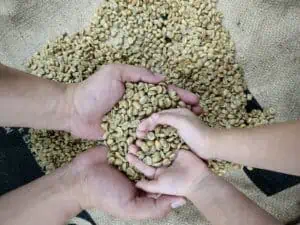
Yellow Pacamara from Mierisch’s Finca La Huella after processing. Courtesy of Kakalove Cafe.
For this month’s tasting report, we decided to take a closer look at these curious varieties. We asked roasters to send in their favorite “big-bean” coffees, and received 75 samples in all. The vast majority were Pacamaras, and it is this variety that fared best in our cupping (some theories about why below). We review the top nine coffees here, eight of which are Pacamaras, along with one impressive Maragogipe.
A Brief History of Big Beans
Maragogipe, also known as “elephant bean,” was discovered growing in a field near the town of Maragogipe in Bahia, Brazil in the late 19th century. It never took off as a single-origin coffee because, though it adapts well to colder climates, it’s porous and difficult to roast and tends to be woody and flat in the cup. While it originated in Brazil, it’s now grown most widely throughout Central America, though in small quantities. Although its main appeal may be the novelty of its gigantic beans, when grown and processed carefully and roasted sensitively, it can deliver a subtly unique sensory profile that leans toward the sweet-savory.
Pacamara, a hybrid of Pacas and Maragogipe, was the culmination of 30 years of research in El Salvador. Pacas, named after the family that discovered this natural mutation of the highly regarded Bourbon variety on their farm in 1956, is a short, hearty tree that is resilient to wind and climate fluctuations, and tends to produce high yields. Pacamara retains the large beans of the Maragogipe but typically produces a deeper, more complex cup. Pacamara was officially rolled out by the Salvadoran Institute for Coffee Research (ISIC) in the 1980s.
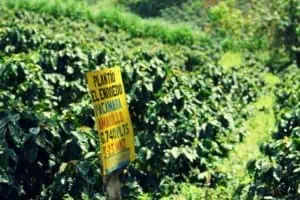
Yellow Pacamara trees growing at Mierisch’s Finca La Huella in Nicaragua. Courtesy of Small Eyes Cafe.
Maracaturra, a hybrid of Maragogipe and Caturra, was developed in Nicaragua by Byron Corrales at Finca Los Pinos, an organic-certified and biodynamic coffee farm. Like Pacas, Caturra is a compact-growing, high-yielding variety that grows well throughout Central America. The Maracaturra was originally offered only through Thanksgiving Coffee, a roaster in Fort Bragg, California known for its pioneering work in sustainability, but it is now also grown in Guatemala and El Salvador and available to consumers by way of a number of specialty coffee roasters in the U.S. and Asia.
On the Cupping Table
Whenever we discover that a coffee we’ve blind-cupped is a Pacamara, Maragogipe or Maracaturra, our interest is piqued. The three of us who regularly cup together have had a running discussion for some time about these big beans, attempting to determine whether they share a common character or overlapping sensory descriptors.
One category of sensation that does often turn up is savory, a basic taste associated with brothy depth. But once we identify it, the questions follow. In a particular sample, is “savory” a positive? (The short answer for us is yes, when it’s juxtaposed with sweetness.) Is the savory element associated with a spice note, an earth-toned accent, an aroma or flavor akin to pipe tobacco? An especially aromatic wood? Perhaps even a non-dessert food or a bittersweet flower? How about fine musk? These are all distinct possibilities when cupping these big-bean varieties.
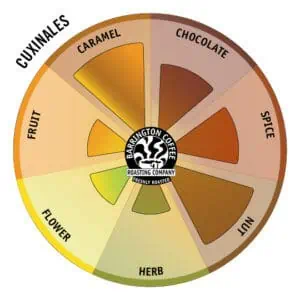
Barrington Coffee’s flavor wheel for its Guatemala Pacamara Los Cuxinales. Courtesy of Barrington Coffee.
The samples we received for this report were far more diverse than suggested by our intermittent experience of these coffees over the last few years. Our expectations were not so much contradicted, as enlarged in often surprising ways. The nine coffees we review here, ranging in score from 92-95, are, at turns, sweetly savory, sweet-tart, bittersweet, and spice-toned. All are vibrant and engaging, with nuances in acidity and mouthfeel.
The Top-Scoring Coffees
While about half of the samples submitted scored a respectable 90-91 or higher, a quarter scored between 84 and 89, and the remaining quarter languished in the 80-83 range, close to falling out of the specialty category entirely. In other words, these big-bean coffees are all over the map from a green-quality and roasting perspective. But the good coffees are very good. And in this cupping, the Pacamara coffees were far and away the most impressive.
Only one non-Pacamara landed in the top nine, the 94-scoring Guatemala La Providencia Maragogype (an alternative spelling to Maragogipe) from Bird Rock Coffee Roasters in San Diego. President and director of coffee Jeff Taylor says that, when this coffee showed up on his table, he was surprised to learn it was a Maragogipe, a variety he’d always pigeonholed as papery and flat. In contrast, this La Providencia is an exciting paradox: high-toned yet deep, with both sweet (wisteria) and bitter-leaning (hops) floral notes.
Even when sourced successfully, these large-beaned varieties present challenges for roasters. Tom Chuang, owner-roaster of Small Eyes Cafe, a nano-roaster in Taiwan, whose Nicaragua Mierisch Yellow Pacamara Honey rated 93, says that the big beans are notoriously difficult to roast because of their unusual size and porousness.

Tom Chuang, of Small Eyes Cafe, at his roastery in Yilan, Taiwan. Courtesy of Small Eyes Cafe.
Ted Stachura, director of coffee at Equator Coffee (El Salvador Finca Himalaya Pacamara, 92) thinks that the reason Pacamara is cupping better than the other varieties, in general, is because “specialty coffee farmers (especially in El Salvador) have been focusing on this variety for many years now and seem to have dialed in the production process in a way that they haven’t with other big-bean types.”
A second high-scoring El Salvador Pacamara, a black-honey processed Finca El Cerro from Red Rooster Coffee Roasters (93), is cleanly fruit-toned with elegant roasted cacao nib underneath. Head roaster Tony Greatorex says the black honey process, involving drying the beans inside the sweet pulp of the coffee fruit, works well for Pacamara, a variety that can sometimes skew “more toward wild and savory than sweet.” “The black honey process,” he says, “emphasizes the sweetness potential and provides pleasing balance and depth.”

Red Rooster’s Pacamara Black Honey from El Salvador. Courtesy of Red Rooster Coffee.
The other Pacamaras we review here are from Guatemala and Nicaragua. The highest-rated coffee in this report is from Fumi Coffee in Taiwan: a natural-processed Guatemala Finca La Hermosa rated 95. Owner-roaster Yu Chih Hao compares this particular Pacamara to Gesha (also spelled Geisha), one of the most expensive coffees in the world. Like Gesha, Pacamara is relatively rare, and he says, “The high altitude at which this coffee was grown gives it a citrusy acidity somewhat like Gesha that adds complexity to the cup.”
Four additional Pacamaras scored 93, two from Guatemala and two from Nicaragua. Augie’s Guatemala Finca Insul is delicate and sweetly spice-toned, while Barrington’s Guatemala Finca Cuxinales impresses with a complex bittersweet balance. Both are washed-process coffees that foreground rich floral tones.
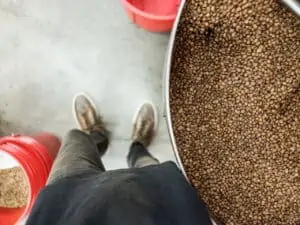
In the roastery at Augie’s in Redlands, California. Courtesy of Augie’s.
Two Nicaraguas, also rated 93, represent the other end of the sensory spectrum, with sweet-tart fruits leading the way, not surprisingly, as one is natural-processed (dried in the fruit), and the other honey-processed (dried in the fruit pulp after the skins were removed). Kakalove Cafe‘s Mierisch Yellow Pacamara Honey (the same green coffee submitted by Small Eyes Cafe, above), combines richly tart tamarind notes with maple syrup and spice tones akin to pink peppercorn and narcissus. And Toronto roaster Hale Coffee Company‘s Finca La Benedicion Natural centers around a cleanly sweet fruit ferment redolent of raspberry liqueur. The ballast here is creamy cashew butter and spicy sandalwood.
If this sampling of coffees is representative, it seems that the Pacamara is potentially quite versatile in its performance across a range processing methods, including washed, natural and variations on honey.
The Big Bean Appeal
What’s the chief appeal of big-bean varieties for consumers? The novelty of the large bean size? The often distinctive cup profile? Perhaps the enigmatic variety names?
Bird Rock’s Maritza Suarez-Taylor, director of quality control, says that the bean size is definitely intriguing for her customers. She adds that, “The relative scarcity of these coffees also provides an opportunity for us to educate people about new varieties.”
Taiwan roasters Huang and Yu Chih Hao agree that the novelty of bean size is an attraction, but rarity is an even more important factor in the Asian market. Their customers are drawn to coffees not easily found elsewhere. Kakalove’s Caesar Tu, a nano-roaster also based in Taiwan, says he has customers who think big beans are inherently better, but in fact he points out that Kakalove’s Yellow Pacamara has a bright acidity that only a certain kind of coffee drinker appreciates. He chose this coffee mainly for its cleanly fruit-forward presentation.
Barth Anderson, co-founder of Barrington Coffee Roasting, agrees. He likes his Cuxinales Guatemala for its tangy acidity, and he adds, “I hazard that the Bourbon roots of the Pacas portion of the Pacamara varietal add to its complexity and vibrancy.”
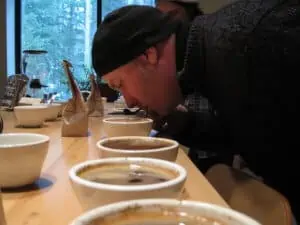
Barrington Coffee’s Barth Anderson at the cupping table. Courtesy of Barrington Coffee.
Stachura doesn’t think bean size is relevant to his customers, given that Equator’s bags are opaque. Still, he points out that the unfamiliar varietal nomenclature is bound to appeal to the adventurous.
Nevertheless, roasters East and West agree that cup quality and character are most important. We agree, though we acknowledge that the more savory-leaning among the coffees reviewed here may not appeal to all coffee drinkers. Their character may differ a little too dramatically from the more familiar coffee types—sweetly tart, roundly chocolaty, or juicily fruit-toned—we typically reward with high ratings. The sweet-savory structure and suggestions of spice, herb, pipe tobacco, aromatic wood or musk make them one version of what we call “caveat coffees,” coffees to which we assign high ratings, but with the implied caveat that their peculiar style of excellence may not please everyone.
We try to alert consumers to the caveats implied in various coffee styles through detailed reviews of individual coffees. Not all of the big-bean samples we tested were impressive, but the best, including the nine reviewed here, offered exceptional departures from the norm.










